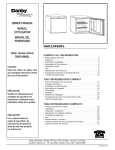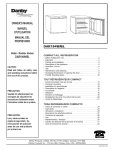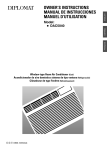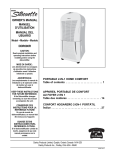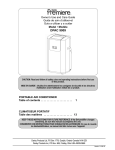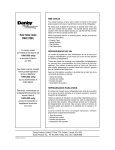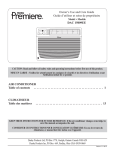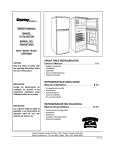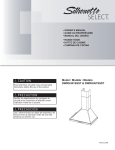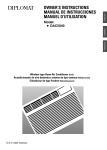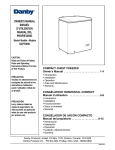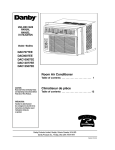Download Danby DAR194 Compact Refrigerator
Transcript
OWNER’S MANUAL MANUEL D'UTILISATION MANUAL DEL PROPIETARIO DAR194W/BL Model • Modèle• Modelo DAR194W/BL CAUTION: Read and follow all safety rules and operating instructions before first use of this product. COMPACT ALL REFRIGERATOR • • • • • • • • • Before Putting Into Use . . . . . . . . . . . . . . . . . . . . . . . . . . . . . . . . . . .2 Important . . . . . . . . . . . . . . . . . . . . . . . . . . . . . . . . . . . . . . . . . . . . . .3 Placing and Installation . . . . . . . . . . . . . . . . . . . . . . . . . . . . . . . . . . .4 Description of the Appliance . . . . . . . . . . . . . . . . . . . . . . . . . . . . . . .5 Operation Control . . . . . . . . . . . . . . . . . . . . . . . . . . . . . . . . . . . . . . .6 Use . . . . . . . . . . . . . . . . . . . . . . . . . . . . . . . . . . . . . . . . . . . . . . . . . .7 Maintenance and Cleaning . . . . . . . . . . . . . . . . . . . . . . . . . . . . . . . .8 Changing the Direction of opening the Door . . . . . . . . . . . . . . . . . . .9 Trouble Shooting Guide . . . . . . . . . . . . . . . . . . . . . . . . . . . . . . . . . .10 TOUT RÉFRIGÉRATEUR COMPACT PRÉCAUTION: Veuillez lire attentivement les consignes de sécurité et les instructions d'utilisation avant l'utilisation initiale de ce produit. PRECAUCIÓN: Lea y observe todas las reglas de seguridad y las instrucciones de operación antes de usar este producto por primera vez. • • • • • • • • • Avant la première mise en service . . . . . . . . . . . . . . . . . . . . . . . . .13 Conseils importants . . . . . . . . . . . . . . . . . . . . . . . . . . . . . . . . . . . . .14 Installation et raccordement . . . . . . . . . . . . . . . . . . . . . . . . . . . . . .15 Description de l’appareil . . . . . . . . . . . . . . . . . . . . . . . . . . . . . . . . .16 Commande . . . . . . . . . . . . . . . . . . . . . . . . . . . . . . . . . . . . . . . . . . .17 Utilisation . . . . . . . . . . . . . . . . . . . . . . . . . . . . . . . . . . . . . . . . . . . . .18 Entretien et nettoyage . . . . . . . . . . . . . . . . . . . . . . . . . . . . . . . . . . .19 Changement du sens d’ouverture de la porte . . . . . . . . . . . . . . . . .20 Guide de dépannage . . . . . . . . . . . . . . . . . . . . . . . . . . . . . . . . . . . .21 TODA REFRIGERADOR COMPACTO • • • • • • • • • Antes de comenzar a usarla . . . . . . . . . . . . . . . . . . . . . . . . . . . . . .24 Importante . . . . . . . . . . . . . . . . . . . . . . . . . . . . . . . . . . . . . . . . . . . .25 Ubicación e instalación . . . . . . . . . . . . . . . . . . . . . . . . . . . . . . . . . .26 Descripción del artefacto eléctrico . . . . . . . . . . . . . . . . . . . . . . . . .27 Controles de operación . . . . . . . . . . . . . . . . . . . . . . . . . . . . . . . . . .28 Uso . . . . . . . . . . . . . . . . . . . . . . . . . . . . . . . . . . . . . . . . . . . . . . . . .29 Mantenimiento y limpieza . . . . . . . . . . . . . . . . . . . . . . . . . . . . . . . .30 Cambio de dirección de la apertura de la puerta . . . . . . . . . . . . . .31 Guía de solución de averías . . . . . . . . . . . . . . . . . . . . . . . . . . . . . .32 R Danby Products Limited, PO Box 1778, Ontario, Canada N1H 6Z9 Danby Products Inc., PO Box 669, Findlay, Ohio, USA 45839-0669 DAR194/10/00 All Refrigerator Thank you for buying a Danby Millennium appliance. We hope it will successfully serve your requirements for many years. This Refrigerator is for domestic use only and is intended for storing fresh foods at temperatures higher than 0˚C/ 32˚F. SAVE THESE INSTRUCTIONS Before Putting Into Use . . . . Instructions for Use We Care for the Environment Tips for Energy Savings Important . . . . . . . . . . . . . . . Disposing of Worn Out Appliances Placing and Installation . . . . Choosing the Right Place Placing the Self-standing Appliance Connection to Power Supply Description of the Appliance Operation Control . . . . . . . . . Temperature Selection . . . . . . . . .2 Use . . . . . . . . . . . . . . . . . . . . . . . . . Storing Fresh Foods Maintenance and Cleaning . . . . . . . Automatic Defrosting of the Refrigerator Cleaning of the Appliance Switch Off the Appliance When Not In Use Changing the Direction of Opening the Door . . . . . . . . . . . . . . Trouble-Shooting Guide . . . . . . . . . . . . . . . . . .3 . . . . . . . . .4 . . . . . . . . .5 . . . . . . . . .6 1 . . . .7 . . . .8 . . . .9 . . .10 Before Putting Into Use • If the gasket is damaged or the door seal is poor, energy consumption is substantially higher. To restore efficiency, replace the gasket. • Always consider instructions stated in sections Positioning and Energy Saving Tips, otherwise the energy consumption is substantially higher. • Before connecting the appliance to electrical power supply, leave it stand for about 2 hours, which will reduce the possibility of malfunctions in the cooling system due to transport handling. • Clean the appliance thoroughly, especially in the interior (See Cleaning and Maintenance). • In case the interior accessories are not correctly placed, rearrange them as described in chapter “Description of the Appliance”. Instructions for Use These instructions for use are intended for the user. They describe the appliance and correct operating procedures for safe use. SAVE THESE INSTRUCTIONS: We Care for the Environment • Our products use environmentally friendly manner. To this end, individual packaging materials are clearly marked. • These instructions are printed either on recycled paper or chlorine free bleached paper. • When your appliance finally wears out, please try not to burden the environment with it; call your nearest authorized service agent. (See Disposing of Worn Out Appliance) Tips for Energy Savings • Try not to open the door too often, especially when the weather is hot and humid. Once you open the door, close it as soon as possible. This is especially important if you have an upright model. • Every now and then check if the appliance is sufficiently ventilated (adequate air circulation behind the appliance). • Set the thermostat from higher to lower settings as soon as possible (depends on how loaded the appliance is, ambient temperatures etc). • Before loading the appliance with packages of fresh foods, make sure that they are cooled to ambient temperature. (excluding soups) • Ice and frost layers increase energy consumption, so clean the appliance as soon as the frost layer is 3-5 mm thick. 2 Important • If you have bought this appliance to replace an old one equipped with a door lock that cannot be opened from the inside (lock, bolt), make sure that the lock is removed, disabled or destroyed before discarding. This will make it impossible for children to accidentally lock themselves inside the appliance and suffocate. • The appliance must be properly connected to an electrical power supply. (See: Connection to Power Supply). • If the food has a strange smell or color, throw it away, because it is very likely that it is spoiled and therefore is dangerous to consume. • Always disconnect the appliance from the power supply before cleaning the appliance, replacing the light bulb and / or attempting repairs. WARNING: repairs should be preformed by qualified service personnel only. • Do not defrost the appliance with other electric appliances (for example a hair dryer) and never attempt to scrape/remove ice/frost with sharp objects. Use only enclosed tools or tools recommended by the manufacturer. • The refrigerating system of the appliance is filled with refrigerant and oil, so when the appliance is damaged, handle it with care and dispose of it in compliance with environmental protection safeguards. (See: We Care for the Environment). • The rating plate containing Model No/Serial No and other technical data specific to this unit, is located either inside the appliance or outside on the rear wall. • The refrigerator system of the appliance is filled with refrigerant and insulating substances which should be separately treated and processed. Call your nearest authorized service agent or specialized servicing center. If you are unable to locate one, contact your local authorities or your distributor. Be careful not to damage the tubes on the rear wall of the appliance (danger of pollution). Dispose of Worn Out Appliances • When your appliance finally wears out, dispose of it in a safe and harmless manner. If the appliance is equipped with a door lock that cannot be opened from the inside (lock, bolt), make sure the lock is removed, disable or destroyed before being discarded. This will make it impossible for children to accidentally lock themselves inside the appliance and suffocate. 3 Placing and Installation CHOOSING THE RIGHT PLACE WARNING Place the appliance in a dry and regularly ventilated room. Never place the appliance near heat emitting devices (e.g. cooking appliances, radiators, water heaters or similar devices) and do not expose to direct sunlight. Instructions pertaining to the risk of fire, electric shock, or injury to persons. GROUNDING INSTRUCTIONS The appliance should be positioned at least 3 cm away from electric or gas cooking appliances and at least 30 cm away from oil or coal fired stoves. If this is not possible, use an appropriate insulation barrier. Behind the appliance there should be a free space at least 200 cm2 wide and above the appliance kitchen units (cupboards) should be at least 5 cm away from the appliance in order to assure adequate ventilation. INSTALLATION Place the appliance firmly on a solid base. Some appliances have adjustable feet on the front side; use them to level the appliance. For your personal safety, this appliance must be grounded. In the event of a malfunction or breakdown, grounding will reduce the risk of electric shock by providing a path of least resistance for electric current. This appliance is equipped with a power cord having an equipment grounding conductor and grounding plug. The plug must be plugged into an appropriate wall outlet that is installed and grounded in accordance with all existing local codes and ordinances. Consult a qualified electrician or serviceman if the grounding instructions are not clearly understood, or if doubt exists as to whether the appliance is properly grounded. CONNECTION TO POWER SUPPLY Connect the appliance power cord and plug to a properly grounded wall outlet. The required nominal voltage and frequency are indicated on the rating plate (inside the unit or on the exterior rear wall of the unit). 4 Description of the Appliance B A C DAR194W/BL (A) Adjustable Wire Shelves (The number of shelves depends on the model) Shelves can be optionally placed on the guides inside the appliance. Perishable foods should be stored towards the back/ rear of the shelves. ie. the coldest part of the shelf. (C) Door Liner The door liner consists of various shelves or holders used for storing eggs, cheese butter and yogurt as well as other smaller packages, tubes, cans etc. The lower shelf is used for storing large bottles. (B) Defrost Water Outlet The interior of the refrigerator is cooled with a cooling plate mounted in the rear wall. Under the plate there is a channel and an outlet for defrost water. Regularly check the defrost water outlet and the drain channel for blockage. They should always be kept free and clean of food particles. If the drain outlet does become clogged, use a plastic straw to clean it. WE RESERVE THE RIGHT TO ALTER THE SPECIFICATIONS WITH NO INFLUENCE ON THE OPERATION OF THE APPLIANCE. 5 Operation Control The temperature of the refrigerator is controlled by setting the thermostat knob. (exterior rear wall of the cabinet) to the desired setting. • Changes in ambient room temperature will affect internal refrigerator temperatures (choose correct setting of the thermostat knob). Temperature Selection • In STOP (0) position the appliance does not operate (cooling system is switched off), yet power supply is not interrupted (the light is on , when you open the refrigerator door). To start the refrigerator, turn the temperature control knob, (exterior rear wall of the cabinet) to the position corresponding to the desired cooling ( on the graduated blue dial ) Fig A • Temperature in the refrigerator also depends on how often the door is opened. The refrigerator temperature will vary depending on the quantity of the food stored and on the frequency with which the door is opened. To turn the control to the “OFF” position, rotate the control knob to the “0” position. If the refrigerator has been left out of use for some time, set the control to maximum for 2-3 hours before turning to the desired position. If the refrigerator is not being used for long time periods, disconnect the plug and leave the door partially open. This will help to reduce mold/mildew from accumulating inside the refrigerator cabinet. FIG A 6 Use Storing Fresh Foods • Crispy and delicate foods should be stored in the coldest parts of the refrigerator. Proper use of the appliance, adequately packed food, correct temperature and taking into account hygienic precautions will substantially influence the quality of the food stored. • Try not to open the door too often. • Set the thermostat to a setting where lowest temperatures are reached. Set the thermostat gradually so as to avoid freezing of foods. Use a thermometer and measure the temperature in the individual compartments. Place the thermostat in a glass vessel filled with water. Temperature readings are most reliable a few hours after a steady state condition is reached. • Foods to be stored in the refrigerator should be properly packed so as to prevent mixing various moisture degrees and odors (in polyethylene bags or sheet, aluminum foil, wax paper, or stored in covered containers or bottles). • Before storing food in the refrigerator, remove excessive packaging (like yogurt in multi-package). • Some organic solutions like volatile oils in lemon and orange peel, acid in butter etc. can cause damage when in contact with plastic surfaces or gaskets for long periods of time. • Pack systematically and make sure that foodstuffs do not touch each other (various odors may mix). Assure adequate air circulation around packages. • Unpleasant odors inside the refrigerator is a sign that something is wrong with foods or that your refrigerator needs cleaning. Unpleasant odors can be eliminated or reduced by washing the interior of the refrigerator with mild solution of water and vinegar. We also recommend using activated carbon filters to clean the air or to neutralize odors. • Never store flammable, volatile or explosive substances. • Beverages with high alcohol percentage shall be stored in tightly sealed bottles in vertical position. • If you are planning a long journey, make sure to remove perishable articles of food out of the appliance before you leave. • Food should not touch the rear wall of the refrigerator • Foods should be cooled down before storing. 7 Maintenance and Cleaning Automatic Defrosting of the Refrigerator Switch Off the Appliance When Not In Use There is no need to defrost the refrigerator, because ice depositing on the inner back wall is defrosted automatically. Ice build-up on the inner back wall during the compressor operation; will (when the compressor has cycled off) defrost automatically. Defrost water collects inside the drain through passing through the drain outlet in the inner back wall into a drain pan situated above the compressor, from where it evaporates. If you do not intend to use the appliance for long periods of time, (vacations) set the thermostat knob to the STOP (0) position, disconnect the power supply, take out the foods and defrost and clean the appliance. Leave the door slightly open. Cleaning the Appliance Disconnect the power bar before cleaning the appliance. Do not use coarse or aggressive cleaning agents as you can damage the surface. Clean the exterior with water and detergent. Remove the detachable accessories in the interior of the appliance and clean with water and liquid detergent. Plastic parts cannot be washed in dishwashers. Wash the interior of the appliance with lukewarm water, adding one or two spoonfuls of vinegar. After cleaning, connect the appliance to power supply and reload it. 8 Changing the Direction of the Door Opening (Swing) If you find the direction of opening the door on your appliance inconvenient, you can change it. Holes on the opposite side have already been prepared in the factory. 9 Trouble-Shooting Guide Sometimes you may come across minor problems that in most cases do not require a service call and can be easily eliminated. The problem may have resulted from improper handling and/or installation of the appliance. Please refer to the below troubleshooting guide to assist you in identifying the possible cause and solution to your problem. Should the problem still persist after completing these checkpoints. Contact the closest authorized service agent in your area for assistance. increased ice formation may be one of the following: the door does not seal well (clean the gasket if it is contaminated, or replace it if it is damaged); –the door is frequently opened or left too long; –the food stored in the refrigerator was warm; –the food or dish is touching the inner back wall. Water is Leaking From the Refrigerator If the discharge water outlet is clogged, or the defrost water drips over the channel, water will leak from the refrigerator. • Clean the clogged outlet, for example with a plastic straw. • Manually defrost the increased ice layer. See “Ice Formation on the Inner rear Wall” The Appliance Fails to Operate After Connecting to Electrical Power Supply • Check the power cord is properly connected. • Check the power supply in the electrical outlet. (blown fuse / circuit breaker) • Make sure the appliance is switched on. (thermostat knob in operating position) Noise Cooling in a refrigerator-freezing appliance is made possible by cooling the system using a compressor, which will produce certain noise levels. How noisy the appliance is depends on where it is placed, how it is used and how old the appliance is. • During the operation of the compressor the noise of the liquid is heard and when the compressor is not operating, the refrigerant flow is heard. This is a normal condition and it has no influence whatsoever on the lifetime of the appliance. • After starting the appliance, the operation of the compressor and the refrigerant flow may be louder, which does not mean that something is wrong with the appliance and it has no influence on the lifetime of the appliance. Gradually the is noise reduced. • Sometimes unusual and louder noise is heard, which is rather unusual for the appliance. This noise is often a consequence of inadequate installation. –The appliance must be level and installed on a firm solid base/floor. –It should not touch the wall or kitchen units standing next to it. –Check the accessories on the interior of the appliance, they should be placed correctly in their positions; also check, bottles, tins, and other vessels are not touching each other causing rattling and/or vibrations. Continuous Operation of the Cooling System • The door is frequently opened or left open for too long. • The door is not properly closed (the door may sag, the gasket may be polluted or damaged). • Perhaps you may have overloaded the appliance with fresh foods. • The reason may be inadequate ventilation of the compressor (assure adequate air circulation). Ice Formation on the Inner Rear Wall As long as the defrost water runs to the channel and through the outlet to the drain pan on the compressor, automatic defrosting of the appliance is assured. In case the ice formation on the inner back wall is increased (3-5 mm), ice should be manually defrosted. Set the thermostat knob to STOP (0) position and leave the door open. Never use electric devices for defrosting and do not scrape the ice or frost layer with sharp objects. After defrosting is complete, turn the knob to desired position and close the refrigerator door.The cause of 10 LIMITED PRODUCT WARRANTY This quality product is warranted to be free from manufacturer’s defects in material and workmanship, provided that the unit is used under the normal operating conditions intended by the manufacturer. This warranty is available only to the person to whom the unit was originally sold by Danby or by an authorized distributor of Danby, and is non-transferable. TERMS OF WARRANTY Plastic parts (ie. evaporator door, door rails, covers and trays are warranted for thirty (30) days only from purchase date, with no extensions provided. First Year During the first year (1), any electrical parts of this product found to be defective, including any sealed system units, will be repaired or replaced, at warrantor’s option, at no charge to the ORIGINAL purchaser. Consumable parts (ie. light bulbs) are not warranted or guaranteed for any length of time. Second Through During the next four years (4) any part of the sealed system found to be defective (consisting of compressor, condenser, evaporator, Fifth Year dryer and all related tubing) will be replaced without charge. The purchaser shall pay for all labor and return freight during this four year (4) period for repair or replacement of any sealed system components. Any unit being diagnosed as non-functional due to sealed system failure and warranting an exchange during the existing four (4) years will be subject to an appropriate depreciation or user fee, including any and all freight charges being levied against the consumer. To Obtain Service Danby reserves the right to limit boundaries of “In Home Service” due to the proximity of an Authorized Service Depot. Any appliance requiring service outside the Limited Boundaries of “In Home Service”, it will be the customer’s responsibility to transport the appliance to the closest Authorized Service Depot at their own expense. Contact your dealer from whom your unit was purchased, or contact your nearest authorized Danby service depot, where service must be performed by a qualified service technician. If service is performed on the units by anyone other than an authorized service depot, or the unit is used for commercial application, all obligations of Danby under this warranty shall be at an end. The following clause refers to single and double door refrigerators, supplied with or without a separate freezer section. Nothing within this warranty shall imply that Danby will be responsible or liable for any spoilage or damage to food or other contents of this appliance, whether due to any defect of the appliance, or its use, whether proper or improper. EXCLUSIONS Save as herein provided, Danby Products Limited (Canada) or Danby Products Inc. (U.S.A.), there are no other warranties, conditions, representations or guarantees, express or implied, made or intended by Danby Products Limited or its authorized distributors and all other warranties, conditions, representations or guarantees, including any warranties, conditions, representations or guarantees under any Sale of Goods Act or like legislation or statue is hereby expressly excluded. Save as herein provided, Danby Products Limited (Canada) or Danby Products Inc. (U.S.A), shall not be responsible for any damages to persons or property, including the unit itself, howsoever caused or any consequential damages arising from the malfunction of the unit and by the purchase of the unit, the purchaser does hereby agree to indemnify and save harmless Danby Products Limited from any claim for damages to persons or property caused by the unit. GENERAL PROVISIONS No warranty or insurance herein contained or set out shall apply when damage or repair is caused by any of the following: 1) Power Failure. 2) Damage in transit or when moving the appliance. 3) Improper power supply such as low voltage, defective house wiring or inadequate fuses. 4) Accident, alteration, abuse or misuse of the appliance such as inadequate air circulation in the room or abnormal operating conditions, (extremely high or low room temperature). 5) Use for commercial or industrial purposes. 6) Fire, water damage, theft, war, riot, hostility, acts of God such as hurricanes, floods etc. 7) Service calls resulting in customer education. Proof of purchase date will be required for warranty claims; so, please retain bills of sale. In the event warranty service is required, present this document to our AUTHORIZED SERVICE DEPOT. Warranty Service With-In Canada With-In United States Refrigerator Single Door In Home Danby Products Limited PO Box 1778, 5070 Whitelaw Road, Guelph, Ontario, Canada N1H 6Z9 Telephone: (519) 837-0920 FAX: (519) 837-0449 In Home 10/99 11 Danby Products Inc. PO Box 669, 101 Bentley Court, Findlay, Ohio, U.S.A. 45839-0669 Telephone: (419) 425-8627 FAX: (419) 425-8629 Le Tout Réfrigerateur Nous sommes reconnaissants de votre achat d'un appareil Danby de l'année millénaire. Nous espérons qu'il vous remplira vos exigences pendant plusieurs années. Ce réfrigérateur est pour l'utilisation domestique seulement et doit être utilisé pour le rangement des aliments frais à la température supérieure à 0 o C / 32o F. Prieur à la mise en marche initiale Directives d'utilisation Nous prenons soins de l'environnement Truc pour la conservation de l'énergie Important . . . . . . . . . . . . . . . . . . . . Comment se défaire des vieux appareils Position et installation . . . . . . . . . . Choisir le bon emplacement Positionnement de l'appareil Raccord à l'alimentation électrique Description de l'appareil . . . . . . . . Description des commandes . . . . . Choix de la température . . .13 Utilisation . . . . . . . . . . . . . . . . . . . . Rangement des aliments frais Soins et entretien . . . . . . . . . . . . . . Décongélation automatique du réfrigérateur Comment nettoyer l'appareil Arrêter l'appareil lorsqu'il n'est pas utiliser Changement de direction de l'ouverture de porte . . . . . . . . . . . . En cas de problème . . . . . . . . . . . . . . .14 . . .15 . . .16 . . .17 SAUVEGARDEZ CES INSTRUCTIONS 12 . . .18 . . .19 . . .20 . . .21 Prieur à la mise en marche • Laisser reposer le réfrigérateur pendant 2 heures avant de le brancher à l'alimentation électrique. Ceci réduit la possibilité de problèmes du système de refroidissement causés par la manutention durant le transport. • Nettoyer complètement l'appareil, spécifiquement l'intérieur (Voir la section de Soins et entretien). • Dans les cas où les accessoires à l'intérieur de l'appareil ne sont pas en bonne position, placez-les de nouveau selon la 'Description de l'appareil'. Directives d'utilisation Ces directives sont pour l'utilisateur. Elles décrivent l'appareil et les procédés appropriés pour le fonctionnement sécuritaire. • Avant de ranger les aliments frais dans l'appareil, il faut s'assurer qu'ils sont à la température ambiante (à l'exception des soupes). • Les couches de glace et de gèle augmentent la consommation énergétique. Nettoyez alors l'appareil aussitôt que la couche atteint de 3 à 5 mm. • Si le joint étanche est endommagé ou si l'étanchéité de la porte est insuffisante, la consommation énergétique est beaucoup plus élevée. Pour rétablir l'énergie, remplacez le joint étanche. • Prenez toujours notes des directives données dans la section 'Position et trucs pour la conservation énergétique', autrement la consommation est bien plus élevée. SAUVEGARDEZ CES INSTRUCTIONS Nous prenons soins de l'environnement • Nos produits sont sécuritaires pour l'environnement. Pour ce bût, les matières individuelles d'emballage sont bien étiquetées. • Ces instructions sont imprimées sois sur du papier recyclé, sois sur du papier sans javellisant. • Lorsque votre appareil est finalement trop vieux, veuillez ne pas endommager l'environnement: Appelez votre agent régional de service. (Voir Comment se défaire d'un vieil appareil). Truc pour la conservation de l'énergie • Essayer de ne pas ouvrir la porte trop souvent, spécifiquement lorsqu'il fait chaud et humide. Une fois la porte est ouverte, fermez-la aussitôt que possible. Ceci est très important si vous possédez un modèle vertical. • De temps à autre, vérifiez que l'appareil a une ventilation suffisante (une circulation d'air adéquate à l'arrière de l'appareil). • Réglez le thermostat de la position plus haute à une plus basse aussitôt que possible (selon la charge d'aliments, la température ambiante, etc.) 13 Important • Si vous avez acheté cet appareil pour remplacer un vieil appareil équipé d'une serrure de porte qui ne s'ouvre pas de l'intérieur (verrou), ce verrou doit être enlevé, mis hors fonctionnement ou détruit avant de se défaire de l'appareil. Ceci empêche la possibilité qu'un enfant s'embarre accidentellement à l'intérieur de l'appareil et prévient l'asphyxie. • L'appareil doit être correctement raccordé à l'alimentation de puissance. (Voir : Raccord à l'alimentation d'électricité). • Si les denrées ont une odeur ou couleur étrange, jetez-les car elles sont sûrement pourries et ne doivent pas être consommées. • Débranchez toujours l'appareil de l'alimentation de puissance avant de le nettoyer, de remplacer la lampe et/ou pour accomplir l'entretien. PRÉCAUTION: les réparations doivent être accomplies seulement par un technicien qualifié. • Ne jamais décongeler l'appareil à l'aide d'autres appareils électriques (tels que les sécheurs à cheveux) et ne grattez/enlevez pas la glace/givre à l'aide d'un instrument coupant. Utilisez seulement les outils fournis par le fabricant. • Le système de réfrigération de l'appareil contient un réfrigérant et de l'huile. Si l'appareil est endommagé, maniez-le avec soins et débarrassezvous de l'appareil en suivant les directives de protection de l'environnement. (Voir: Nous prenons soins de l'environnement). • La plaque signalétique qui contient les numéros de série et de modèle, ainsi que les données techniques de l'appareil, se trouve sois à l'intérieur de l'appareil ou sur la paroi arrière à l'extérieur de l'appareil. • Le système de réfrigération de votre appareil contient un réfrigérant et des matières d'isolation qui devraient être traitées séparément. Téléphonez votre représentant régional de service ou un centre de service spécialisé. Si vous ne pouvez pas en trouver un, consultez les autorités régionales ou votre distributeur. Prenez soins de ne pas endommager les serpentins qui se trouvent sur le mur arrière de l'appareil (danger de pollution). Pour se défaire des vieux appareils • Lorsque vous devez enfin vous défaire de votre vieil appareil, faites-le d'une façon sécuritaire qui ne causera pas de dommage. Si l'appareil est équipé d'une serrure de porte qui ne s'ouvre pas de l'intérieur (verrou), ce verrou doit être enlevé, mis hors fonctionnement ou détruit avant de se défaire de l'appareil. Ceci empêche la possibilité qu'un enfant s'embarre accidentellement à l'intérieur de l'appareil et prévient l'asphyxie. 14 Position et Installation CHOISIR LE BON EMPLACEMENT PRÉCAUTION Consignes de sécurité au sujet du risque d'incendie, de choc électrique, ou blessures corporelles. Situer l'appareil dans un endroit sec et à bonne circulation d'air. Ne jamais positionner l'appareil proche d'un générateur de chaleur (ex. Appareil de cuisson, radiateurs, chauffe eau, ou autres appareils semblables) et jamais exposer l'appareil au rayon direct du soleil. INSTRUCTIONS DE MISE À LA TERRE L'appareil doit être situé à au moins 3 cm d'un appareil de cuisson au gaz ou électrique et au moins 30 cm des fours à mazout ou au charbon. Si ceci est impossible, utilisez un dispositif approprié d'isolation. L'espace libre à l'arrière de l'appareil devrait être d'une largeur d'au moins 200 cm2 et celle entre l'appareil et les armoires au-dessus devrait être au moins 5 cm pour assurer une ventilation adéquate. INSTALLATION Situer l'appareil sur une base solide. Certains appareils ont des pattes avant réglables, utilisez-les pour mettre l'appareil à niveau. Pour votre sécurité, cet appareil doit être mis à la terre. En cas de mauvais fonctionnement ou de pannes, la mise à la terre réduit le risque de choc électrique en fournissant une échappatoire au courant électrique. L'appareil est muni d'un cordon électrique comprenant un fil de mise à la terre et une fiche de terre. Brancher la fiche dans une prise de courant correctement installée et mise à la terre selon les normes et codes régionaux. Consulter un électricien ou un technicien qualifié si vous ne comprenez pas les instructions de mise à la terre ou si vous avez un doute quelconque sur la bonne mise à la terre de l'appareil. RACCORD À L'ALIMENTATION ÉLECTRIQUE Brancher le cordon d'alimentation de l'appareil à une prise de courant murale correctement mise à la terre. La tension nominale et la fréquence exigées sont indiquées sur la plaque de classification de l'appareil (à l'intérieur de l'appareil ou sur le caisson au dos de l'appareil). 15 Description de l’appareil A B C DAR194W/BL (A) Tablettes (le nombre et le type de tablettes dépendent du modèle) La tablette peut être située sur les guides à l'intérieur de l'appareil selon votre goût. Elle est dotée d'un dispositif sécuritaire qui empêche que la tablette soit glissée et déplacée. Si vous voulez enlever la tablette, soulevez-la légèrement par le devant et retirez-la. Les aliments périssables devraient ranger vers l'arrière du réfrigérateur. (C'est-à-dire, la section plus froide de la tablette.) (B) Bouche d'écoulement d'eau de dégivrage L'intérieur du réfrigérateur est refroidi par une plaque de refroidissement installé dans la paroi du fond du réfrigérateur. Sous la plaque se trouve une rainure et une bouche pour l'eau de dégivrage. Vérifier régulièrement cette bouche de dégivrage et la rainure contre toute obstruction. Elles doivent toujours être propres et libres de toutes particules d'aliments. Si la bouche est bloquée, nettoyez-la à l'aide d'une paille en plastique. (C) Paroi de porte La paroi de porte contient des clayettes en porte-àfaux pour le rangement des œufs, fromages, beurres et yaourt ainsi que plusieurs autres petits contenants, tubes, cannettes, etc. La clayette inférieure est utilisée pour le rangement de grosses bouteilles. NOUS RÉSERVONS LE DROIT DE MODIFIER LES SPÉCIFICATIONS QUI N'ONT AUCUNE INFLUENCE SUR LE FONCTIONNEMENT DE L'APPAREIL. 16

















